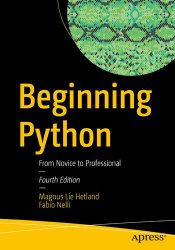 Название
Название: Beginning Python: From Novice to Professional, 4th Edition
Автор: Magnus Lie Hetland, Fabio Nelli
Издательство: Apress
Год: 2024
Страниц: 620
Язык: английский
Формат: pdf (true), epub (true)
Размер: 39.3 MB
Gain a fundamental understanding of Python’s syntax and features with this revised introductory and practical reference. Covering a wide array of Python–related programming topics, including addressing language internals, database integration, network programming, and web services, you’ll be guided by sound development principles.
Updated to reflect the latest in Python programming paradigms and several of the most crucial features found in Python 3, Beginning Python, Fourth Edition also covers advanced topics such as extending Python and packaging/distributing Python applications. Ten accompanying projects will ensure you can get your hands dirty in no time.
In the Chapter 1, you learn how to take control of your computer by speaking a language it understands: Python. Nothing here is particularly difficult, so if you know the basic principles of how your computer works, you should be able to follow the examples and try them out yourself. I’ll go through the basics, starting with the excruciatingly simple, but because Python is such a powerful language, you’ll soon be able to do pretty advanced things.
The Chapter 2 introduces a new concept: data structures. A data structure is a collection of data elements (such as numbers or characters, or even other data structures) that is structured in some way, such as by numbering the elements. The most basic data structure in Python is the sequence. Each element of a sequence is assigned a number—its position, or index. The first index is zero, the second index is one, and so forth. Some programming languages number their sequence elements starting with one, but the zero-indexing convention has a natural interpretation of an offset from the beginning of the sequence, with negative indexes wrapping around to the end. If you find the numbering a bit odd, I can assure you that you’ll most likely get used to it pretty fast. This chapter begins with an overview of sequences and then covers some operations that are common to all sequences, including lists and tuples. These operations will also work with strings, which will be used in some of the examples, although for a full treatment of string operations, you have to wait until the next chapter. After dealing with these basics, we start working with lists and see what’s special about them. After lists, we come to tuples, a special-purpose type of sequence similar to lists, except that you can’t change them.
You will:
Become a proficient Python programmer by following along with a friendly, practical guide to the language’s key features
Write code faster by learning how to take advantage of advanced features such as magic methods, exceptions, and abstraction
Gain insight into modern Python programming paradigms including testing, documentation, packaging, and distribution
Work through several interesting projects, including a P2P file–sharing application, chat client, video game, remote text editor, and more
Who This Book Is For:
Programmers, novice and otherwise, seeking a comprehensive introduction to the Python programming language.
Скачать Beginning Python: From Novice to Professional 4th Edition
[related-news]
[/related-news]